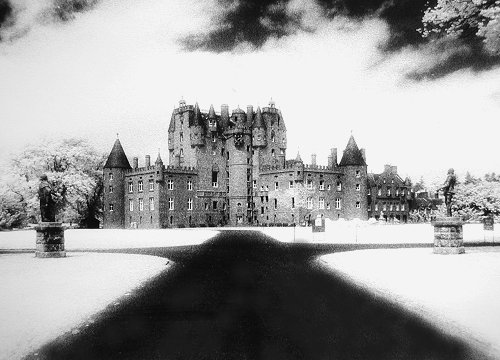Glamis Castle


As far as the 8th century Glamis was a special place, and St. Fergus came from Ireland and was said to have preached to the Picts there. King Malcolm II of Scotland died in Glamis in 1034, and his son Duncan I, was slain by his cousin, the notorious MacBeth in 1040. He then ruled for 18 years as the last Celtic King of Scotland.
In 1372 King Robert II, the first Stewart King of Scotland created Sir John Lyon of Forteviot "Thane of Glamis" and gave him Glamis Castle, which had been used previously as a royal hunting lodge. Four years later Sir John, who may have been a Pict Thane prior to his Scottish title, married the king's daughter, Joanna, and was appointed Chamberlain of Scotland. Their descendants still live there.
Their grandson became Lord Glamis in 1445, the title "Earl of Strathmore" was created in 1606, and the title "Earl of Strathmore and Kinghorne" in 1677. The family name became Bowes-Lyon in 1767. Before the 18th century, there were numerous outer defenses made of walls and towers; these were torn down in the 1790's, as the violent clan wars of Scotland's past slowed down. All that is left of the outer defenses are two small turrets, a sundial and the statues of James VI and his son, Charles I.
Many legends are told about Glamis, and ancient Pictish ogham stones have been found around the castle. A secret chamber is thought to be deep within the castle walls. In this chamber one of the Lords of Glamis and the "Tiger" Earl of Crawford of nearby Edzell Castle played cards with the Devil himself on the Sabbath. So great were the consequences that the room was sealed 300 years later.
Glamis is famous as the renowned setting for Shakespeare's famous tragedy "Macbeth" and as the childhood home of the Queen Mother of Great Britain who, before her marriage to the late King George VI, was Lady Elizabeth Bowes-Lyon. Among the oldest and most haunting parts of the castle is Duncan's Hall, which commemorates the slaying of King Duncan by Macbeth. Although the actual killing took place near Elgin, this is the traditional Shakespearean scene of the crime.
This photograph won the Best of Show at the 17th Annual National Photography Competition in Arkansas and numerous Honorable Mentions in various Art Competitions. The entire edition has been sold and it's out of print.

